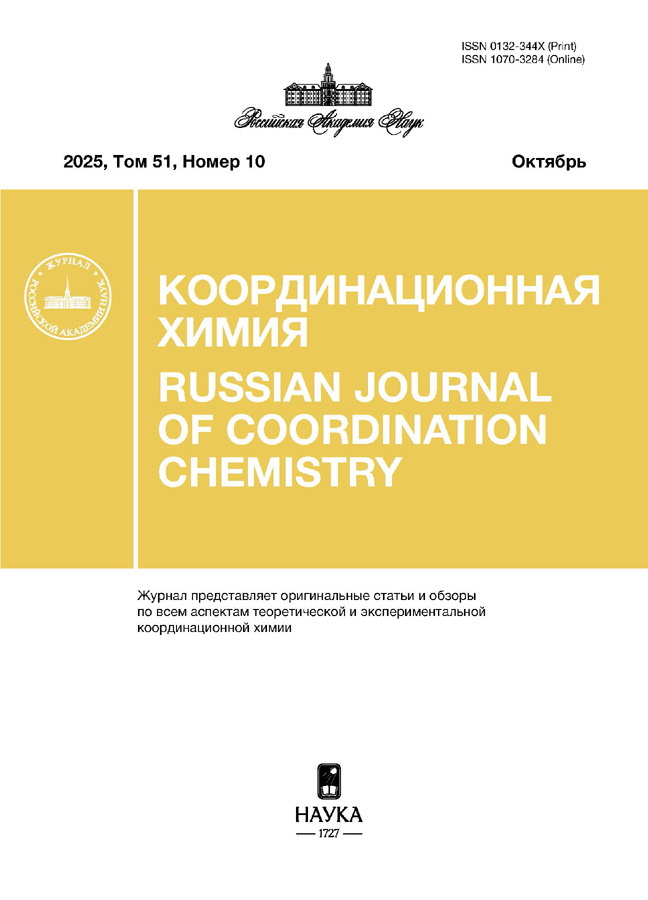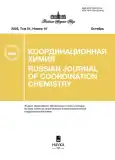Koordinacionnaâ himiâ
ISSN (print): 0132-344X
Media registration certificate: № 0110216 от 08.02.1993
Founders: Kurnakov Institute of General and Inorganic Chemistry of RAS, Russian Academy of Sciences
Editor-in-Chief: Eremenko Igor L., academician RAS, Doctor of Sc., Full Professor
Frequency / Access: 12 issues per year / Subscription
Included in: White list (2nd level), Higher Attestation Commission list, RISC
Current Issue
Vol 51, No 10 (2025)
Articles
Characteristics of (N-thiocyanato)chromates(III) of lanthanides(III) with pyridine-3-carboxylic acid
Abstract
To complete the studies of double complex compounds, (N-thiocyanato)chromates(III) of lanthanide complexes with pyridine-3-carboxylic acid, new compounds of the compositions [LnL3(H2O)2][Cr(NCS)6] · · nH2O (Ln = Pr (I), n = 1.5; Sm (II), Gd (III), Tb (IV), n = 2; L = C6H5NO2). The substances were studied by chemical analysis, IR spectroscopy, and PXRD (CCDC No. 2427051–2427054). In the crystal structures of complexes I–IV, the cation has a chain structure due to the bidentate-bridging function of pyridine-3-carboxylic (nicotinic) acid molecules. The coordination environment of the lanthanide atoms consists of eight oxygen atoms belonging to six nicotinic acid molecules and two coordinated H2O molecules, located at the vertices of a distorted square antiprism. In the isolated [Cr(NCS)6]3– anions, the Cr coordination polyhedron consists of the N atoms of six thiocyanate ions and is close to a regular octahedron. In the structures of complexes I–IV, the space between polymeric cations is filled with complex anions and crystallization water molecules. Additionally, the structure is stabilized by intermolecular hydrogen bonds.
Koordinacionnaâ himiâ. 2025;51(10):603-610
 603-610
603-610


Synthesis and Crystal Structure of Cobalt Complexes with Cucurbit[6]uril
Abstract
Four cobalt complexes with cucurbit[6]uril (CB[6]), [Co(H2O)6](Bdc) · CB[6] · 14.5H2O (I), 2(H2NMe2)2[CoCl4] · CB[6] ·12H2O (II), [{Co(H2O)4Cl}4(CB[6])]Cl4 · 9H2O (III) and [Co(H2O)6]-[Co(H2O)5(Dmf)][CoCl4]2 · CB[6] · 6H2O (IV), were prepared by evaporation of the reaction solution containing cobalt chloride and cucurbit[6]uril (CB[6]). According to X-ray diffraction data, compound I is formed by packing of cationic cobalt aqua complexes, terephthalate anions, and CB[6] molecules linked together by hydrogen bonds with crystallization water molecules into a supramolecular cage. The structure of compound II represents a packing of CB[6] molecules, dimethylammonium cations, and anionic cobalt chloro complexes. Compound III contains tetranuclear cationic cobalt chloro aqua complexes with CB[6], with chloride anions acting as counter-ions. The crystal structure of IV is a packing of cationic cobalt aqua complexes, anionic cobalt chloro complexes, and CB[6] molecules linked by hydrogen bonds with crystallization water molecules into a supramolecular cage. The resulting compounds are characterized by IR spectra and elemental analysis data.
Koordinacionnaâ himiâ. 2025;51(10):611-620
 611-620
611-620


Complexes of pivaloyltrifluoroacetonates of potassium and rubidium with 18-crown-6 ether: synthesis, structure, thermal properties
Abstract
In the search for volatile fluorinated compounds of potassium and rubidium, new complexes of the corresponding pivaloyltrifluoroacetonates (Ptac) with 18-crown-6 ether, [K(18C6)(Ptac)] (I) and [Rb(18C6)(Ptac)] (II), were synthesized. The compounds were characterized by elemental analysis, IR spectroscopy, and X-ray fluorescence analysis, and their structures were studied by X-ray diffraction in the range of 100–400 K (CCDC nos. 2429226–2429232 (I), 2429233–2429239 (II)). The complexes are isostructural and have an insular mononuclear structure, with M…H and M…C contacts involving the tert-butyl group between fragments, forming chains. The thermal expansion tensors are elongated along this direction. X-ray diffraction analysis showed that the rubidium cation in such a complex can complete its coordination sphere with a solvent molecule (chloroform, CCDC no. 2429240 (IIs)). For I, II, and IIs, Hirshfeld surfaces were analyzed and a search for pseudoperiodicity in the crystal packings was carried out by the translational sublattice method. Thermogravimetric analysis showed that, unlike the initial pivaloyltrifluoroacetonates, complexes I and II are volatile and promising for testing in gas-phase processes of thin-film material deposition.
Koordinacionnaâ himiâ. 2025;51(10):621-633
 621-633
621-633


Structure and properties of magnesium complexes with bulky β-diketones: 2,2,6,6-tetramethylheptane-3,5-dione and its methoxy-substituted derivative
Abstract
In order to study the effect of bulky terminal substituents in the β-diketonate ligand on the structure and properties of volatile magnesium compounds, complexes with 2,2,6,6-tetramethylheptane-3,5-dione (HThd) and, for the first time, with 2-methoxy-2,6,6-trimethylheptane-3,5-dione (HZis) were obtained. The complexes [Mg2(L)4] (L = Thd (I), Zis (II)), the synthesis intermediates [Mg(H2O)2(L)2] (L = Thd (III), Zis (IV)), and aqua derivative [Mg2(H2O)(Zis)4] (V) were characterized by elemental analysis and IR spectroscopy. The structures of binuclear complexes and the synthesis by-product [Mg7(Zis)6(μ-OH)6]Cl2·5CHCl3 (VI) were established by X-ray diffraction (CCDC nos. 2424128 (Ia, a new polymorph), 2424130 (II), 2424129 (V), 2424126 (V · 1/2CHCl3), 2424127 (VI)). Both [Mg2(L)4] molecules are characterized by asymmetric environment of metal centers (Mg C.N. is 5, 6), but in I, three μ,κ2:κ1-ligands occupy bridging positions, while in II, two ligands have different coordinations (μ,κ2:κ1 and μ,κ2(O,O′):κ2(O′,OOMe)). The inclusion of water in II to give V is not accompanied by a considerable rearrangement of the structure, but C.N. of the unsaturated metal center changes from 5 to 6. It was shown by thermogravimetry that complex I is more volatile and low-melting than II.
Koordinacionnaâ himiâ. 2025;51(10):634-647
 634-647
634-647


Scandium(iii) 1,1,1-trifluorohexane-2,4-dionate complex: Synthesis, structure, and thermal properties
Abstract
A new scandium(III) 1,1,1-trifluorohexane-2,4-dionate complex [Sc(5Htfac)3] was synthesized, purified, and characterized by elemental analysis, NMR spectroscopy, and mass spectrometry. Its structure was determined at 150 K by X-ray diffraction analysis (CCDC No. 2433044). The complex has a molecular structure in which the bidentate cyclic ligands are arranged according to the os-isomer. Shortened H…F interactions were identified in the structure. The thermal properties were studied by TGA and DSC, and the fusion temperature (309.3 ± 0.5 K), enthalpy (ΔfusH°(Tfus) = 36.0 ± 1.4 kJ mol–1), and entropy (ΔfusS°(Tfus) = = 116.5 ± 4.5 J mol–1 K–1) of fusion were determined. The temperature dependence of the saturated vapor pressure was measured by the flow method (343–433 K) and the static method with a membrane null manometer (410–470 K). On this basis, the thermodynamic characteristics of evaporation at average and standard temperatures were calculated (ΔvapH°(298.15 K) = 100.2 ± 1.3 kJ mol–1, ΔvapS°(298.15 K) = = 201.8 ± 2.8 J mol–1 K–1). From these data, the sublimation parameters of the complex were obtained (ΔsubH°(298.15 K) = 135.3 ± 1.9 kJ mol–1, ΔsubS°(298.15 K) = 315.3 ± 5.4 J mol–1 K–1). The structure and thermal properties of [Sc(5HTfac)3] were compared with those of two scandium(III) β-diketonates bearing methyl and tert-butyl substituents in the ligand.
Koordinacionnaâ himiâ. 2025;51(10):648-657
 648-657
648-657


Coordination Compounds of Rare-Earth Nitrates with Acetamide
Abstract
Coordination compounds of rare-earth nitrate with acetamide (АА), [Ln(AA)4(NO3)3], Ln = La (I), Ce (II), Pr (III), Nd (IV), [Sm(AA)3(H2O)(NO3)3] (V), and [Ln(AA)3(NO3)3], Ln = Tb (VI), Dy (VII), Er (VIII), Yb (IX), were synthesized and characterized by physicochemical methods (ICP-MS, elemental analysis, IR spectroscopy, X-ray diffraction, thermal gravimetric analysis, differential scanning calorimetry). Molecular structures of complexes I, II, IV, V, VIII were determined by X-ray single-crystal diffraction (CIF files CCDC № 2370600 (I); 2203371 (II); 2203372 (IV); 2370601 (V); 2370602 (VIII)). Thermal analysis of the compounds was studied in a wide temperature range. The prepared coordination compounds can be used for the synthesis of nanosized oxides.
Koordinacionnaâ himiâ. 2025;51(10):658-668
 658-668
658-668










